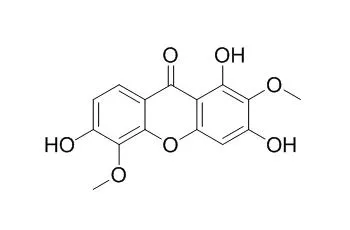METHODS AND RESULTS:
We used recombinant yeast assay (RYA), with the strain BY4741 of Saccharomyces cerevisiae, and Ames test, with strains TA100, TA98, TA97a and TA102 of Salmonella typhimirium, to evaluate estrogenicity, mutagenicity and antimutagenicity of methanolic extracts of Syngonanthus dealbatus (S.d.), Syngonanthus macrolepsis (S.m.), Syngonanthus nitens (S.n.) and Syngonanthus suberosus (S.s.), and of 9 compounds isolated from them (1=luteolin, 2=mix of A-1,3,6-trihydroxy-2-methoxyxanthone and B-1,3,6-Trihydroxy-2,5-dimethoxyxanthone, 3=1,5,7-trihydroxy-3,6-dimethoxyxanthone, 4=1,3,6,8-tetrahydroxy-2,5-dimethoxyxanthone, 5=1,3,6,8-tetrahydroxy-5-methoxyxanthone, 6=7-methoxyluteolin-8-C-β-glucopyranoside, 7=7-methoxyluteolin-6-C-β-glucopyranoside, 8=7,3'-dimethoxyluteolin-6-C-β-glucopyranoside and 9=6-hydroxyluteolin). The results indicated the estrogenic potential of the S. nitens methanol extract and four of its isolated xanthones, which exhibited, respectively, 14.74±1.63 nM; 19.54±6.61; 7.20±0.37; 6.71±1.02 e 10.01±4.26 nM of estradiol-equivalents (EEQ). None of the extracts or isolated compounds showed mutagenicity in any of the test strains and all of them showed antimutagenic potential, in particular preventing mutations caused by aflatoxin B1 (AFB1) and benzo[a]pyrene (B[a]P).
CONCLUSIONS:
The results show that the xanthones, only isolated from the methanol extract of S. nitens capitula, probably were the responsible for its estrogenic activity and could be useful as phytoestrogens, providing a new opportunity to develop hormonal agents. In addition, flavones and xanthones could also be used as a new antimutagenic agent. Since, the mutagens are involved in the initiation and promotion of several human diseases, including cancer, the significance of novel bioactive phytocompounds in counteracting these pro-mutagenic and carcinogenic effects is now gaining credence. |






 Cell. 2018 Jan 11;172(1-2):249-261.e12. doi: 10.1016/j.cell.2017.12.019.IF=36.216(2019)
Cell. 2018 Jan 11;172(1-2):249-261.e12. doi: 10.1016/j.cell.2017.12.019.IF=36.216(2019) Cell Metab. 2020 Mar 3;31(3):534-548.e5. doi: 10.1016/j.cmet.2020.01.002.IF=22.415(2019)
Cell Metab. 2020 Mar 3;31(3):534-548.e5. doi: 10.1016/j.cmet.2020.01.002.IF=22.415(2019) Mol Cell. 2017 Nov 16;68(4):673-685.e6. doi: 10.1016/j.molcel.2017.10.022.IF=14.548(2019)
Mol Cell. 2017 Nov 16;68(4):673-685.e6. doi: 10.1016/j.molcel.2017.10.022.IF=14.548(2019)